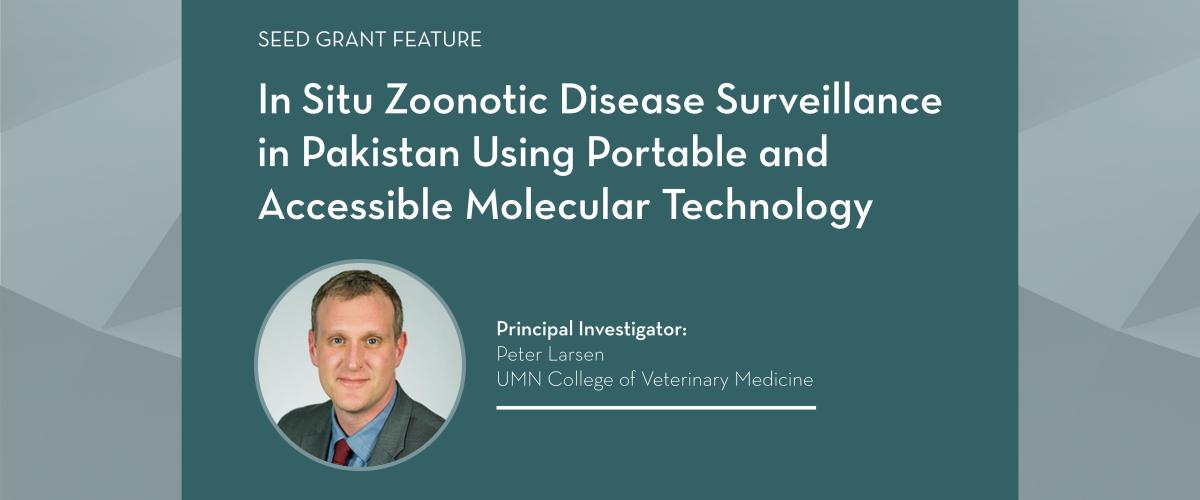Seed Grant Feature: Studying Zoonotic Disease in Pakistan
Peter Larsen’s interest in science and biology started with bats.
Larsen, PhD, spent time studying the winged mammals as an undergraduate and became drawn to their diversity and varied abilities.
“There are over 1,400 species of bats. There are bats that specialize in feeding on fish, that actually glide over the water and catch fish. There are carnivorous bats that eat birds. The diversity is amazing, so that’s what got me excited,” said Larsen.
Today, as an assistant professor at the University of Minnesota’s College of Veterinary Medicine, Larsen still studies bats. But his primary interest is zoonotic disease and identifying pathogens that have the potential to transfer from animals to humans.
Larsen was a 2023 Global Health Seed Grant recipient and will travel to Pakistan this summer to study tick-borne pathogens. The work, funded by the Center for Global Health and Social Responsibility, is an important collaboration as zoonotic diseases become more common, said Larsen.
“It definitely seems like tick-borne pathogens are on the rise in Central Asia, especially in Pakistan,” he said. “Tick-borne encephalitis virus, Crimean-Congo haemorrhagic fever, these are a major concern. There are also unrecognized tick-borne pathogens circulating.”

Larsen emphasized that the project is a prime example of a meaningful global partnership between himself and his co-investigator Haroon Ahmed, PhD, of COMSATS University Islamabad.
Ahmed is an expert in tick surveillance and parasitology, while Larsen and his team provide knowledge on identifying potential pathogens in the ticks that are collected.
“So you can envision what that means if you bring those two teams together, like the Seed Grant has, you have an expert on identifying the ticks, collecting the ticks throughout the country, and then you have a team that specializes in identifying all potential zoonoses that may be circulating in those samples,” said Larsen.
“That’s just huge if you can bring those two teams together. And that’s what the Seed Grant has done for us.”
Tracking pathogens in ticks — or any animal — provides a record of potential diseases that researchers can refer to in the future. That record can be used to learn more about diseases that end up transfering to humans.
“We preserve these samples so that, if we do find something that is of interest and that does cross over some time in the future, then you can go back and you can really just dig in and leverage that,” said Larsen.
These international collaborations, like those offered through the Seed Grant, have paid dividends to Larsen, his co-investigators and students. Larsen notes that the first Seed Grant he received from CGHSR led to at least two dissertations from students working under Dr. Faisal Ali Bin Anwarali Khan, Larsen’s co-investigator.
"These seed grants are investments that our center makes in partnerships,” said CGHSR Executive Director Shailey Prasad, MD, MPH. “We hope that these grants become an important impetus for work between the co-PIs, and, as the name suggests, grow into larger and ongoing projects between the partners."
The experience with the Seed Grant program has given Larsen an opportunity to pursue international scientific research that supports his view of the importance of global collaboration.
Mentoring students and advancing their scholarship is something Larsen enjoys most.
“That’s really what it’s all about. On both sides, the opportunities for students to exchange ideas, to just witness, to be part of and facilitate these collaborations is significant for the students,” said Larsen.
“It’s at the heart of what we do as faculty in higher education, to make students really excited about science so that they continue that in their careers.”
And, Larsen said, these collaborations have the potential to lead to further scientific partnerships and discoveries in the future.
“If this is done the right way, the long-term benefits for all individuals involved as part of the research team are amazing. Those benefits cascade for years into the future,” he said.
